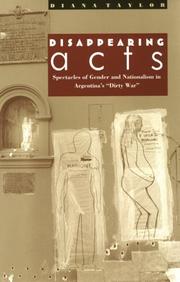| Listing 1 - 4 of 4 |
Sort by
|

ISBN: 9780822331360 9780822331230 0822331233 0822331365 0822385317 1282921037 9786612921032 Year: 2003 Publisher: Durham (N.C.) : Duke university press,
Abstract | Keywords | Export | Availability | Bookmark
 Loading...
Loading...Choose an application
- Reference Manager
- EndNote
- RefWorks (Direct export to RefWorks)
Diana Taylor provides a new understanding of the vital role of performance in the Americas. From plays to official events to grassroots protests, performance, she argues, must be taken seriously as a means of storing and transmitting knowledge. Taylor reveals how the repertoire of embodied memory--conveyed in gestures, the spoken word, movement, dance, song, and other performances--offers alternative perspectives to those derived from the written archive and is particularly useful to a reconsideration of historical processes of transnational contact. The Archive and the Repertoire invites a remapping of the Americas based on traditions of embodied practice. Examining various genres of performance including demonstrations by the children of the disappeared in Argentina, the Peruvian theatre group Yuyachkani, and televised astrological readings by Univision personality Walter Mercado, Taylor explores how the archive and the repertoire work together to make political claims, transmit traumatic memory, and forge a new sense of cultural identity. Through her consideration of performances such as Coco Fusco and Guillermo Gómez-Peña's show Two Undiscovered Amerindians Visit, Taylor illuminates how scenarios of discovery and conquest haunt the Americas, trapping even those who attempt to dismantle them. Meditating on events like those of September 11, 2001 and media representations of them, she examines both the crucial role of performance in contemporary culture and her own role as witness to and participant in hemispheric dramas.
Sociology of minorities --- Theatrical science --- America --- #VCV monografie 2005 --- #SBIB:39A5 --- #SBIB:39A74 --- #SBIB:316.7C210 --- Kunst, habitat, materiële cultuur en ontspanning --- Etnografie: Amerika --- Cultuursociologie: kunst: algemeen --- Ethnicity --- Memory --- Minorities --- North and south. --- Performance art --- Performing arts --- Postcolonialism and the arts --- Postcolonialism --- Social aspects --- Social conditions. --- Political aspects --- Civilization. --- Ethnic relations. --- Social conditions --- North and south --- Arts, Modern --- Happenings (Art) --- Post-colonialism --- Postcolonial theory --- Political science --- Decolonization --- Arts and postcolonialism --- Arts --- Show business --- South and north --- Acculturation --- Culture conflict --- Retention (Psychology) --- Intellect --- Psychology --- Thought and thinking --- Comprehension --- Executive functions (Neuropsychology) --- Mnemonics --- Perseveration (Psychology) --- Reproduction (Psychology) --- Ethnic identity --- Group identity --- Cultural fusion --- Multiculturalism --- Cultural pluralism --- Ethnic minorities --- Foreign population --- Minority groups --- Persons --- Assimilation (Sociology) --- Discrimination --- Ethnic relations --- Majorities --- Plebiscite --- Race relations --- Segregation --- Americas --- New World --- Western Hemisphere --- Mémoire --- Art de performance --- Arts du spectacle --- Art et histoire --- Société --- Aspect politique --- Mémoire --- Société
Book
ISBN: 9780822359548 9780822359975 9780822375128 0822359545 0822359979 0822375125 Year: 2016 Publisher: Durham, N.C. Duke University Press
Abstract | Keywords | Export | Availability | Bookmark
 Loading...
Loading...Choose an application
- Reference Manager
- EndNote
- RefWorks (Direct export to RefWorks)
Taylor's fascinating, multicultural analysis of performance explores not only what performance is but also what it does?what it allows one to see, to experience, and to theorize?and ?its complex relation to systems of power? (to quote from chapter 1). This is Taylor?s English-language adaptation of the Spanish edition of Performance, which was written in concert with the Hemispheric Institute of Performance and Politics, an association of artist-activists, universities, and institutions throughout the Americas, of which Taylor is founding director. The illustrations, most of which come from the institute?s archive, represent a wide range of politically charged work in the spirit of Augusto Boal and Bertolt Brecht, most of it from the Western hemisphere. A small, glossy volume with sleek typography that draws the eye to the book's salient points, Performance comprises chapters on performance frames, histories, uses, and means of political activism, and it features the work of noted "artivists" (artist-activists) Marina Abramović, Nao Bustamante, Regina José Galindo, H.I.J.O.S., and Yes Men, among others. Taylor closes with the admonition that ?performance is world-making. [One] needs to understand it.? This book helps accomplish that goal.
Art --- Theatrical science --- Performance art. --- Performance art --- Art de performance --- Political aspects. --- Aspect politique --- Performance --- Arts, Modern --- Happenings (Art) --- Performing arts --- Political aspects

ISBN: 0822318776 0822318687 9780822318774 9780822318682 0822399288 Year: 1997 Publisher: Durham Duke University Press
Abstract | Keywords | Export | Availability | Bookmark
 Loading...
Loading...Choose an application
- Reference Manager
- EndNote
- RefWorks (Direct export to RefWorks)
In Disappearing Acts Diana Taylor looks at how national identity is shaped, gendered, and contested through spectacle and relationship. The specific identity in question is that of Argentina, and Taylor's focus is directed toward the years 1976 to 1983 in which the Argentine armed forces were pitted against the Argentine people in that nation's "Dirty War." Combining feminism, cultural studies, and performance theory, Taylor analyzes the political spectacles that comprised the war - concentration camps, torture, "disappearances"--As well as the rise of theatrical productions, demonstrations, and other performative practices that attempted to resist and subvert the Argentine military. Taylor uses performance theory to explore how public spectacle both builds and dismantles a sense of national and gender identity. Here, nation is understood as a product of communal "imaginings" that are rehearsed, written and staged - and spectacle is the desiring machine at work in those imaginings. Taylor argue that the founding scenario of Argentineness stages the struggle for national identity as a battle between men - fought on, over, and through the feminine body of the Motherland. She shows how the military's representations of itself as the model of national authenticity established the parameters of the conflict in the 70s and 80s, feminized the enemy, and positioned the public - limiting its ability to respond. Those who challenged the dictatorship, from the Mothers of the Plaza de Mayo to progressive theater practitioners, found themselves in what Taylor describes as "bad scripts." Describing the images, myths, performances, and explanatory narratives that have informed Argentina's national drama, Disappearing Acts offers a telling analysis of the aesthetics of violence and the disappearance of civil society during Argentina's spectacle of terror.
Argentine drama --- Disappeared persons --- Theater --- Violence --- History and criticism. --- Political aspects --- History --- Argentina --- Politics and government --- #SBIB:309H241 --- #SBIB:328H32 --- Violent behavior --- Social psychology --- Dramatics --- Histrionics --- Professional theater --- Stage --- Theatre --- Performing arts --- Acting --- Actors --- History and criticism --- Andere media: functies, genres, historiek --- Instellingen en beleid: Midden en Latijns-Amerika --- Missing persons --- Victims of state-sponsored terrorism

ISBN: 8437604702 9788437604701 Year: 1984 Volume: 198 Publisher: Madrid: Cátedra,
Abstract | Keywords | Export | Availability | Bookmark
 Loading...
Loading...Choose an application
- Reference Manager
- EndNote
- RefWorks (Direct export to RefWorks)
| Listing 1 - 4 of 4 |
Sort by
|

 Search
Search Feedback
Feedback About UniCat
About UniCat  Help
Help News
News